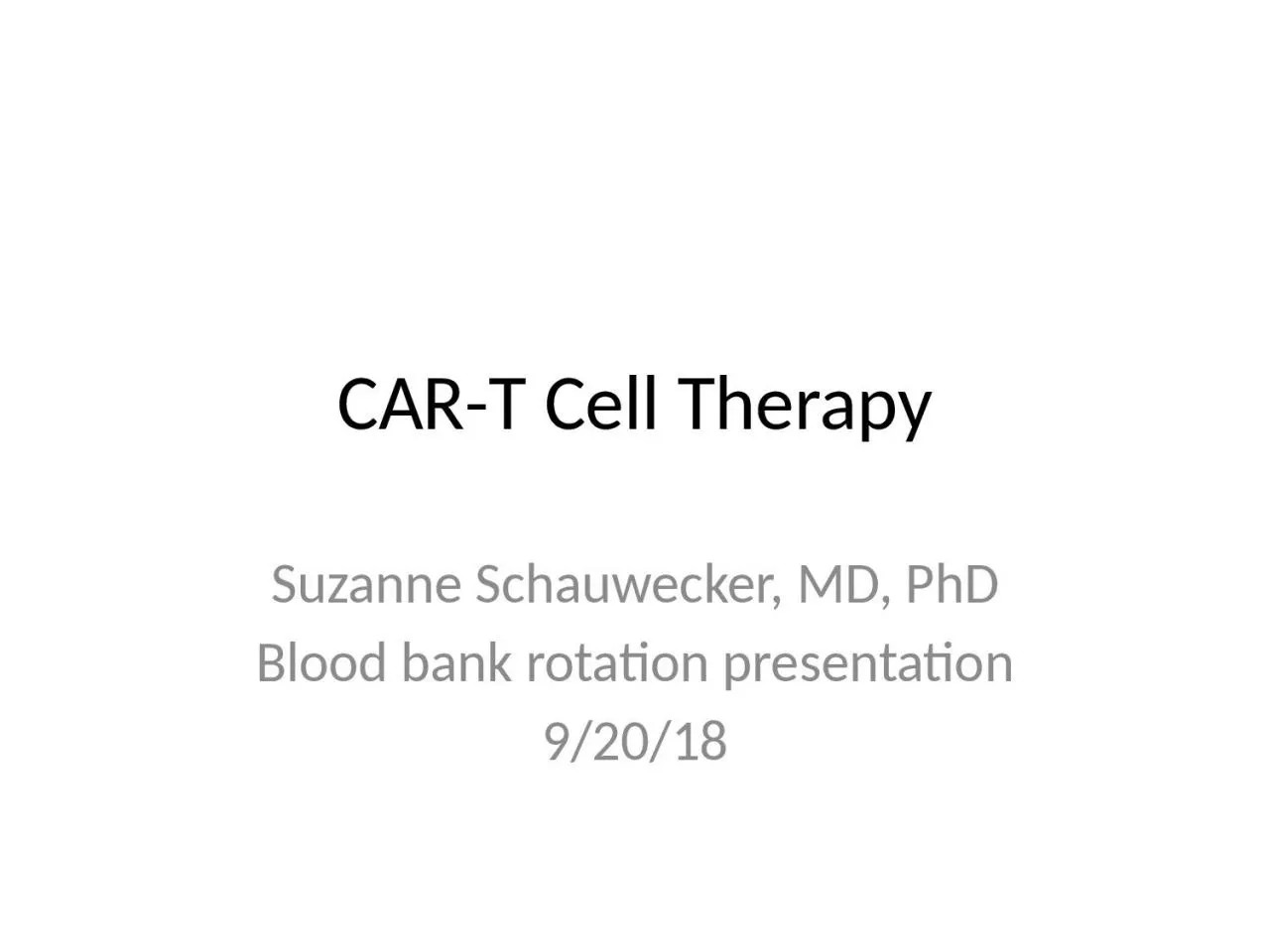

Blood bank rotation presentation 92018 Outline Mechanism of CAR T cell therapy Manufacturing process Challenges of expanding CAR T cell therapy to a larger patient population worldwide ID: 1042320
Download Presentation The PPT/PDF document "CAR-T Cell Therapy Suzanne Schauwecker, ..." is the property of its rightful owner. Permission is granted to download and print the materials on this web site for personal, non-commercial use only, and to display it on your personal computer provided you do not modify the materials and that you retain all copyright notices contained in the materials. By downloading content from our website, you accept the terms of this agreement.
1. CAR-T Cell TherapySuzanne Schauwecker, MD, PhDBlood bank rotation presentation9/20/18
2. OutlineMechanism of CAR T cell therapyManufacturing processChallenges of expanding CAR T cell therapy to a larger patient population world-wideHarmonization of standards nationally and internationally
3. Chimeric antigen receptor (CAR)-T cell therapyT cells are removed from the patient’s bloodEngineered to express a chimeric antigen receptorReprograms T cells to target tumor cells
4. CAR T cell therapy – Where are we?Tisagenlecleucel (CTL019) is FDA-approved for patients up to 25 years of age with B-cell precursor ALL (refractory or in second or greater relapse) and for patients with DLBCL (relapsed and refractory)KTE-C19/axicabtagene ciloleucel (axi-cel) is FDA-approved for patients with NHL or DLBCL (relapsed and refractory)Currently being investigated in several hematologic and solid tumor types144 current clinical trials in the US, 240 in China, Australia, Austria, Belgium, Canada, France, Germany, Israel, Italy, Japan, Netherlands, Norway, Russia, Singapore, Spain, Sweden, Switzerland, Thailand, United Kingdom
5. Mechanism of CAR T Cell TherapyCARs: genetically engineered fusion proteinsAntigen recognition domain derived from a monoclonal antibodyIntracellular T cell signaling and costimulatory domainsClinical development of anti‐CD19 chimeric antigen receptor T‐cell therapy for B‐cell non‐Hodgkin lymphoma, Volume: 108, Issue: 6, Pages: 1109-1118, First published: 16 March 2017, DOI: (10.1111/cas.13239)
6. Mechanism of CAR T Cell TherapyCARs: genetically engineered fusion proteinsAntigen recognition domain derived from a monoclonal antibodyIntracellular T cell signaling and costimulatory domainsClinical development of anti‐CD19 chimeric antigen receptor T‐cell therapy for B‐cell non‐Hodgkin lymphoma, Volume: 108, Issue: 6, Pages: 1109-1118, First published: 16 March 2017, DOI: (10.1111/cas.13239)
7. Mechanism of CAR T Cell TherapyEngineered to express a chimeric antigen receptorReprograms T cells to target tumor cellsClinical development of anti‐CD19 chimeric antigen receptor T‐cell therapy for B‐cell non‐Hodgkin lymphoma, Volume: 108, Issue: 6, Pages: 1109-1118, First published: 16 March 2017, DOI: (10.1111/cas.13239)
8. CD19: Target for B cells
9. Manufacturing of Tisagenlecleucel
10. T Cell ActivationArtificial antigen-presenting cells: anti-CD3/anti-CD28 beadsIL-2
11. Manufacturing of TisagenlecleucelTransduction: incubation with a viral vector encoding the CAR
12. Manufacturing of TisagenlecleucelCulture expansion takes 9-11 days and may reach up to 5 L
13. Clinical Process for Tisagenlecleucel
14. Manufacturing of Tisagenlecleucel
15. Challenges of Expanding to Larger Patient PopulationsScaling CAR T cell therapyWider range of indicationsLarger patient populationsComplex manufacturing processSome aspects are semi-automatedOthers are manualGenerating consistently high-quality viral vectorPredictable genetic modification of cellsSterilityThe final CAR T cell product must be individually generated for each patientChain of custody regulationsGlobal regulatory concerns
16. Challenges of Expanding CAR T Cell Therapy GloballyDonor screening and testing, traceability and labeling, patient confidentiality, and apheresis requirements vary widely among countriesDonor starting material and final product may be shipped internationallyRequirements for quality control of starting materials varyRequirements for the human or animal serum used for cell culture differGreater global regulatory collaboration and harmonization is necessary
17. Harmonization of StandardsThe clinical trial approval process is not yet fully harmonized between European Union member statesThis may change in 2019 when a new regulation goes into effect
18. Harmonization of StandardsCAR T cells are considered genetically modified organisms (GMOs)GMOs are regulated differently among EU member statesLegislation and application forms were drafted with plant GMOs in mind
19. Harmonization of StandardsGMO applications are often managed by a different government agency than the competent health authoritySome countries require a public consultationRisk of releasing confidential data to the public
20. Harmonization of StandardsDifferent EU member states regard WBCs as blood-derived products vs. tissues and cells for further manufacturingVarious labeling and cell donor testing requirements vary across countries
21. Harmonization of StandardsNCCN task force report on CAR T cell therapyMultidisciplinary panel of experts in oncology, cancer center administration, and health policyMet for the first time in March 2018Report published this month
22. CD19 CAR T Cell Therapy, Management of Toxicities
23. Follow-Up
24. Operational Considerations
25. OutlineMechanism of CAR T cell therapyManufacturing processChallenges of expanding CAR T cell therapy to a larger patient population world-wideHarmonization of standards nationally and internationally
26. ReferencesLevine BL, Miskin J, Wonnacott K, Keir C. Global manufacturing of CAR T cell therapy. Molecular Therapy: Methods & Clinical Development. 2017;4:92-101.Makita S, Yoshimura K, Tobinai K. Clinical development of anti-CD19 chimeric antigen receptor T-cell therapy for B-cell non-Hodgkin lymphoma. Cancer Science. 2017;108(6):1109-1118.Buechner J, Kersten MJ, Fuchs M, Salmon F, Jager U. Chimeric antigen receptor-T cell therapy: Practical considerations for implementation in Europe. HemaSphere. 2018;2:1.Ogba N, Arwood NM, Bartlett NL, Bloom M, Brown P, Brown C, Lihua Budde E, Carlson R, Farnia S, Fry TJ, Garber M, Gardner RA, Gurschick L, Kropf P, Reitan JJ, Sauter C, Shah B, Shpall EJ, Rosen ST. Chimeric antigen receptor T cell therapy. NCCN Task Force Report. J Natl Compr Canc Netw 2018;16(9):1092–1106.Locke FL, Davila ML. Regulatory challenges and considerations for the clinical application of CAR-T cell anti-cancer therapy. Expert Opinion on Biological Therapy. 2017;17(6):659-661.Maus MV, Nikiforow S. The why, what, and how of the new FACT standards for immune effector cells. Journal for ImmunoTherapy of Cancer. 2017;5:36.